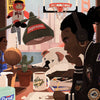
03/2021 design & fashion visual culture
A sleepy bulldog is lightly snoring against the hazy backdrop of a summery day as its animated owner tosses scrunched balled-up sketches into a basketball hoop—Joe Prytherch is a designer whose work appears to have no bounds, with each of his depictions as atmospheric and evocative as the last.
Whether a music-fused animation for Kamaal Williams that magnetically transports you into the heart of a neon-lit Peckham or a set of World Cup host cards that poetically captures the ubiquity of the event's multiculturalism, Prytherch's Lo-Fi designs visualize every detail you can imagine and also the ones you rarely notice. The viewer drifts to the movement of a skater, feels the isolation and creative block of working from home, and the sensitiveness of a pianist playing in a murky, poorly lit cellar. Like cinematic masterpieces, his creations allow you to immerse in that soul-stirring environment, to experience something that is both beautiful and provocative. It is a window to revisiting familiar places in unfamiliar times. After a year of sheltered existence and most days feeling identical, his energized visuals are expressive artworks that remind us of a world before lockdown—even if that's a lucid subway carriage swaying to the movement of the rush-hour commute.

Illustrating and animating the cover of UK Esquire's summer fiction issue, Prytherch captured the essence of a summer lockdown in the city. The Chicago Bulls documentary 'The Last Dance' plays on the laptop, a takeaway slice of pizza remains in a recently consumed Franco Manca box, while someone reads Albert Camus' novel 'The Plague' during a pandemic.
On Instagram, Prytherch is known as 'Mason London.' Once the art director of Boiler Room, he made the freelance leap a few years back and now collaborates with the likes of Esquire, Bombay Bicycle Club, and Lily Allen to name a few. For years he's been developing a nostalgic style that captures the streetwear culture of New York and London in the 1990s, mixed with Blade Runner-like neon lights. He says this style is a reference to the interests he developed during "adolescence, fighting to get out." Popular culture imports flooded Britain, like much of the world, from America in the 1990s. Movies would often premiere nearly a year after the stateside release, when his friends went to visit America and came back to tell the tales at school, it was like "they’d taken a trip to the future." It was a magical time and these moments stayed with him forever. In a time before Google and social media, Prytherch taught himself to imagine what was happening in America, in a way envisioning the 'future.' Through trial and error, his aesthetic would later gravitate to the moments that inspired his youth.
Hidden amongst his depictions are references to movements and people that shaped that decade. Michael Jordan and the Chicago Bulls were kings of the NBA, J Dilla and the Notorious B.I.G dominated the radio waves, and skate brand Supreme captured the changing cultural tide of fashion. What separates Prytherch from other designers is his unreal attention to tiny details and cloistered popular cultural relics. These range from a shrouded Franco Manca pizza box in a recent Esquire piece to progressive literature of the moment camouflaged into the backdrop. The detail is essential to him, "I enjoy drawing them—it’s fun to try and mimic different styles whether that be packaging design, architecture, or interior design," he explains to us. The little touches make the scene feel more realistic. "Any time someone looks at a real-life street scene there will be a lot of peripheral detail that they take in subconsciously but maybe couldn’t recall if they were asked about, so I like to use this effect in my work," and social media enhances this effect more. "The benefit I have is that if someone is looking at one of my animations on Instagram then they can watch it multiple times and try and spot all these details, so I get the credit for drawing them in the end anyway," he jokes about the continuous looping.
To create one piece of animated work, he jumps between three to four programs. He draws on Adobe Illustrator, then imports the piece to Photoshop to arrange and save as PNGs which composition together in After Effects. He designs on Adobe Animate for the frame by frame stuff and After Effects for tweening and compositing everything together. The looping animations can take anywhere from a week to a month to make depending on the level of detail and length of the clip. This rigorous process requires recognition, he's even been labeled the 'Lionel Messi of illustration,’ to which he laughingly replies, "I’d rather be the Michail Antonio of illustration because I’m a West Ham fan."
The way he harmonizes music with visuals seems so effortless. Prytherch has completely conquered it—just like art that makes the music speak. Looking at recent projects for Kamaal Williams and Dua Lipa, we discuss what creative processes he goes through to envision the scenes while hearing the tune. He describes this as his "post rationalizing" stage, it's the musicology of concept. He'll spend countless hours listening to the music, jotting down ideas until he has a good gut feeling. "If I was to deconstruct it, I guess I’m isolating a particular mood that I’ve gotten from the music and then putting that into whatever I draw," he explains. Using the Kamaal Williams animation as an example, he says, "I think the music sounds futuristic but has a very strong grounding in Peckham and London music culture, so each thing I drew in the scene I thought 'how do I make sure this represents both parts of that mood?.' So I drew a lot of local Peckham businesses but reimagined them in little futuristic pod shops. Or I used lots of clean, modern lighting but made the street look messy with a load of rubbish everywhere because even in 1000 years people in London will still leave their empty beer cans on top of bus stops."


Above we see the artwork that Prytherch created for Kiefer's 'Bridges' EP, which he also created countless animations for the Stones Throw record release. Below we see a brand new artwork released on the Mason London online print shop, with a percentage of the sale going directly to charity. (Artworks: Joe Prytherch)
In the past year, each piece of work that Prytherch has released appears more conceptual than the last—like more craft and hunger have gone into the style. Lockdown hasn't changed his music consumption, nor did fatherhood at the end of 2020. But it has altered his senses somewhat, "if anything, the new emotions from both of these things have brought about has allowed me to connect with music in ways I didn’t before." He considers himself lucky to be a designer and animator for a living, but he also sees his “drawing and animation style as a work in progress, there are always things I’m trying to improve which leads me to try new techniques and keeps me interested."
The likes of Dust La Rock, So-Me, and Parra were artistic figures that drew his attention while growing up and shaped his craft. To him, the fact that these designers drew by hand was appealing, and that they "all drew with a great sense of fun." But they also ignored the classic rules of graphic design, which made their work more ambiguous to him. "Dust La Rock used to do flyers for Fool's Gold shows and rather than doing a simple, legible poster with each artist written on a separate line, he’d draw a Letterman jacket with all the artists as patches on it, some the right way up, some sideways and some upside down," which made them harder to read than standard graphic design posters. To him they had "so much more personality and had a load of tiny details that took time to appreciate. You’d almost have to search out all the information but it was so fun to do, making it fun just to look at a poster is a real skill."
The art of adding personality into graphic design, alongside a meticulous eye for detail, are traits that Prytherch shares with the creatives he idolized. It is these extra details that make their styles instantly recognizable. While the generation before him made their marks through graphic posters, Prytherch is making his through the unison of music with a graphic that connects with a viewer's emotional state. His creations transport you into elegantly graphic scenes, but the musical elements touch on a more soulful level. The distinctive moods typically touch on nostalgia, mystery, and romance—where he seems to get the atmosphere just right, every time. The intricate details in his looping designs keep each animation interesting, regardless of how many times you view it. With regard to what’s next for Prytherch, a hopeful fan recently commented on one of his nostalgic creations: “Give this man a team and let him do a movie.”
See more of Joe Prytherch's work and animations on his Instagram. Discover more boundary-pushing visual culture through a selection of gestalten titles.











